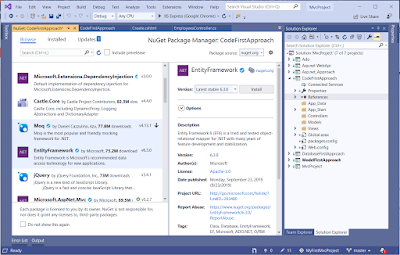Code First Approach:
First Create new project in Visual
studio 2019
1. Right
Click on Solution Explore -> Add -> New Projects -> Select Asp.Net Web
Application(.Net Framework) using C# code ->Next ->Project
Name(CodeFirstApproach) ->Create
2. Select
a template -> Empty -> Check MVC -> ok.
Project
is created with MVC folder
Step 1: Add Entity
Right click on references ->
Manage NuGet Packages -> Browse -> click EntityFramework -> Install
Now added the entity framework in
references folder.
Step 2: Create model class
Right click on Models folder ->
Add -> Class -> Name (EmployeeModel.cs) ->ok, its created a
EmployeeModel.cs and type the following code:
using
System;
using
System.Collections.Generic;
using
System.ComponentModel.DataAnnotations;
using
System.Linq;
using
System.Web;
namespace
CodeFirstApproach.Models
{
public class EmployeeModel
{
[Key]
public int EmpId
{ get; set; }
public string
EmpName { get; set; }
public int
EmpSalary { get; set; }
}
}
Add one more class like
EmployeeContext.cs and type following code
using
System.Data.Entity;
namespace
CodeFirstApproach.Models
{
public class EmployeeContext :
DbContext
{
public EmployeeContext() : base(“Constr”)
{
}
public
DbSet<EmployeeModel> EmployeeModels { get; set; }
}
}
Now,
this DbContext will do many things for us such as it will create databases and
tables. You can check your newly added database file.
DbSet: This class represents an entity set that is used for the CRUD operations.
Connection string in web.config
<connectionStrings>
<add name="Constr" connectionString="Data
Source=LENOVO-PC; Initial Catalog=CodeFirstApproach; UID=sa; pwd=likhil@2013;" providerName="System.Data.Sqlclient"/>
</connectionStrings>
Step 3: Add Controller
Right click on controllers folder
-> Add -> Controller -> MVC5 Controller – Empty -> Add ->
Name(EmployeeController.cs) -> Add
Past the below code in EmployeeController.cs
page
using
System;
using
System.Collections.Generic;
using
System.Linq;
using
System.Web;
using
System.Web.Mvc;
using
CodeFirstApproach.Models;
namespace
CodeFirstApproach.Controllers
{
public class EmployeeController :
Controller
{
public
EmployeeContext db = new EmployeeContext();
// GET: Employee
public
ActionResult Index()
{
return
View(db.EmployeeModels.ToList());
}
[HttpGet]
public
ActionResult Create()
{
return
View();
}
[HttpPost]
public ActionResult
Create(EmployeeModel emp)
{
db.EmployeeModels.Add(emp);
int i =
db.SaveChanges();
if (i
> 0)
{
return
RedirectToAction("Index");
}
else
{
return
View();
}
}
[HttpGet]
public ActionResult Edit(int? Id)
{
EmployeeModel obj =
db.EmployeeModels.Find(Id);
return View(obj);
}
[HttpPost]
public ActionResult Edit(EmployeeModel emp)
{
if (ModelState.IsValid)
{
db.Entry(emp).State =
EntityState.Modified;
db.SaveChanges();
return RedirectToAction("Index");
}
return View(emp);
}
[HttpGet]
public ActionResult Details(int? id)
{
EmployeeModel employeeModel =
db.EmployeeModels.Find(id);
return View(employeeModel);
}
[HttpGet]
public ActionResult Delete(int? Id)
{
return View();
}
[HttpPost]
[ActionName("Delete")]
public ActionResult Deleteconform(int? Id)
{
EmployeeModel employeeModel =
db.EmployeeModels.Find(Id);
db.EmployeeModels.Remove(employeeModel);
db.SaveChanges();
return RedirectToAction("Index");
}
}
}
Step 4: Add Views
Right Click on Index method in
EmployeeController.cs page -> Add View -> add view template will be open
don’t change any thing then click Add, then copy the following code in
Index.cshtml page
@model List<CodeFirstApproach.Models.EmployeeModel>
@{
ViewBag.Title = "Index";
}
<h2>Index</h2>
<table>
<tr>
<th>EmpId</th>
<th>EmpName</th>
<th>EmpSalary</th>
</tr>
@foreach (var item in Model)
{
<tr>
<td>@item.EmpId</td>
<td>@item.EmpName</td>
<td>@item.EmpSalary</td>
</tr>
}
</table>
Copy code in Create.cshtml page
@{
ViewBag.Title = "Create";
}
<h2>Create</h2>
@using (Html.BeginForm())
{
@Html.Label("EmpName");
@Html.TextBox("EmpName");
<br />
@Html.Label("EmpSalary");
@Html.TextBox("EmpSalary");
<br />
<input type="submit" value="Save" class="btn
btn-success" />
}
Copy code in Edit.cshtml page
@model CodeFirstApproach.Models.EmployeeModel
@{
ViewBag.Title = "Edit";
}
<h2>Edit</h2>
@using (Html.BeginForm())
{
@Html.Hidden("EmpId", Model.EmpId)
@Html.Label("EmpName")
@Html.TextBox("EmpName", Model.EmpName)
<br />
@Html.Label("EmpSalary")
@Html.TextBox("EmpSalary", Model.EmpSalary)
<br />
<input type="submit" value="Save" class="btn
btn-default" />
}
<div>
@Html.ActionLink("Back to List", "Index")
</div>
Right click on Details method in EmployeeController.cs page then click add view, its show the dailog box like below
You Select the details like above then click Add button, it will genarated Details.cshtml page like below.
@model CodeFirstApproach.Models.EmployeeModel
@{
ViewBag.Title = "Details";
}
<h2>Details</h2>
<div>
<h4>EmployeeModel</h4>
<hr />
<dl class="dl-horizontal">
<dt>
@Html.DisplayNameFor(model => model.EmpName)
</dt>
<dd>
@Html.DisplayFor(model => model.EmpName)
</dd>
<dt>
@Html.DisplayNameFor(model => model.EmpSalary)
</dt>
<dd>
@Html.DisplayFor(model => model.EmpSalary)
</dd>
</dl>
</div>
<p>
@Html.ActionLink("Edit", "Edit", new { id =
Model.EmpId }) |
@Html.ActionLink("Back to List", "Index")
</p>
You Select the details like above then click Add button, it will genarated Delete.cshtml page like below.
@model CodeFirstApproach.Models.EmployeeModel
@{
ViewBag.Title = "Delete";
}
<h2>Delete</h2>
<h3>Are you
sure you want to delete this?</h3>
<div>
<h4>EmployeeModel</h4>
<hr />
<dl class="dl-horizontal">
<dt>
@Html.DisplayNameFor(model => model.EmpName)
</dt>
<dd>
@Html.DisplayFor(model => model.EmpName)
</dd>
<dt>
@Html.DisplayNameFor(model => model.EmpSalary)
</dt>
<dd>
@Html.DisplayFor(model => model.EmpSalary)
</dd>
</dl>
@using
(Html.BeginForm()) {
@Html.AntiForgeryToken()
<div class="form-actions no-color">
<input type="submit" value="Delete" class="btn
btn-default" /> |
@Html.ActionLink("Back
to List", "Index")
</div>
}
</div>



No comments:
Post a Comment